TOYOTA AVENSIS 2015 Owners Manual
Manufacturer: TOYOTA, Model Year: 2015, Model line: AVENSIS, Model: TOYOTA AVENSIS 2015Pages: 648, PDF Size: 39.64 MB
Page 571 of 648
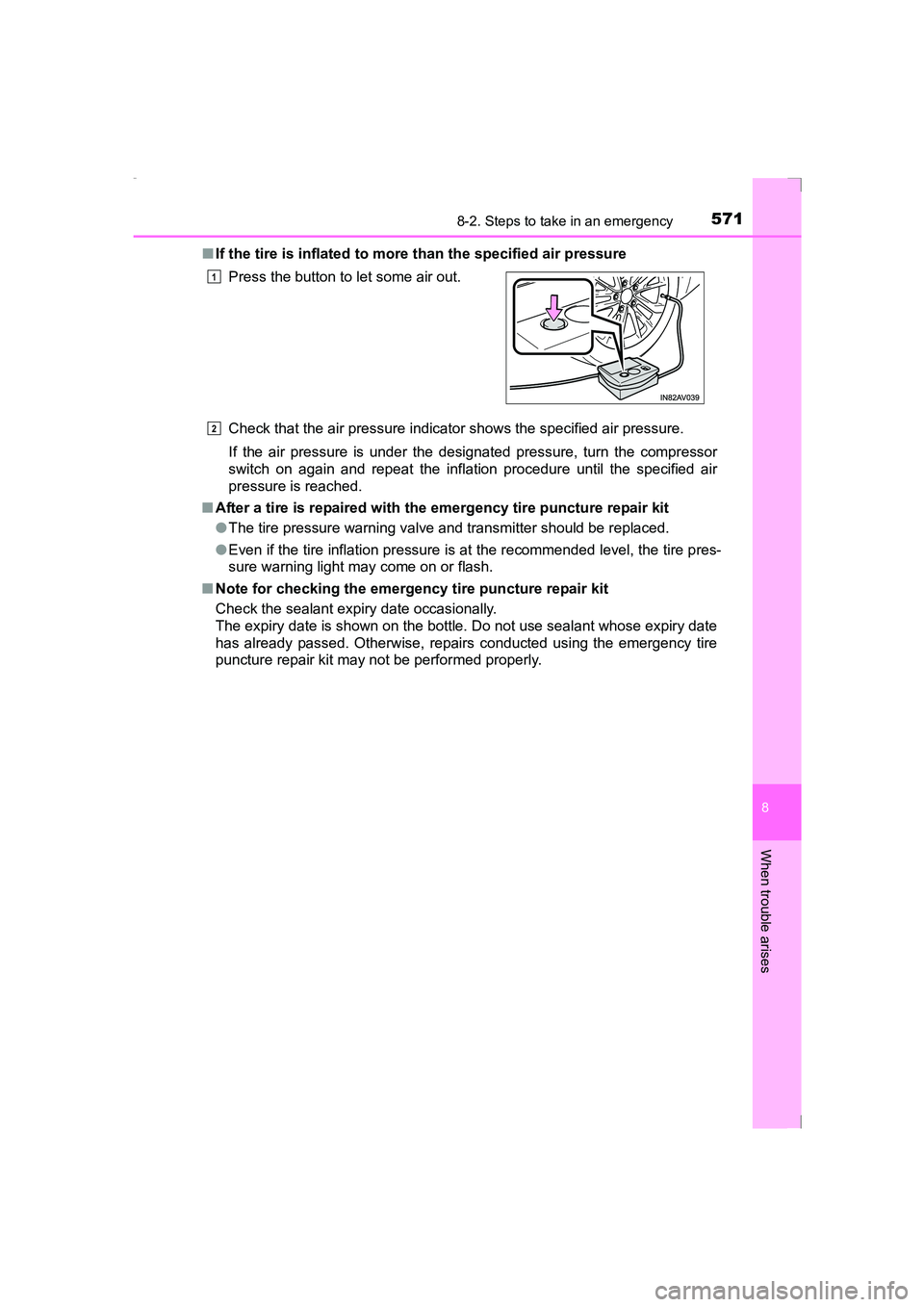
5718-2. Steps to take in an emergency
AVENSIS_OM_OM20C20E_(EE)
8
When trouble arises
■If the tire is inflated to mo re than the specified air pressure
Check that the air pressure indicator shows the specified air pressure.
If the air pressure is under the designated pressure, turn the compressor
switch on again and repeat the inflation procedure until the specified air
pressure is reached.
■ After a tire is repaired with the emergency tire puncture repair kit
●The tire pressure warning valve and transmitter should be replaced.
● Even if the tire inflation pressure is at the recommended level, the tire pres-
sure warning light may come on or flash.
■ Note for checking the emergency tire puncture repair kit
Check the sealant expiry date occasionally.
The expiry date is shown on the bottle. Do not use sealant whose expiry date
has already passed. Otherwise, repairs conducted using the emergency tire
puncture repair kit may not be performed properly.Press the button to let some air out.
1
2
AVENSIS_OM_OM20C20E_(EE).book Page 571 Thursday, January 29,
2015 1:47 PM
Page 572 of 648
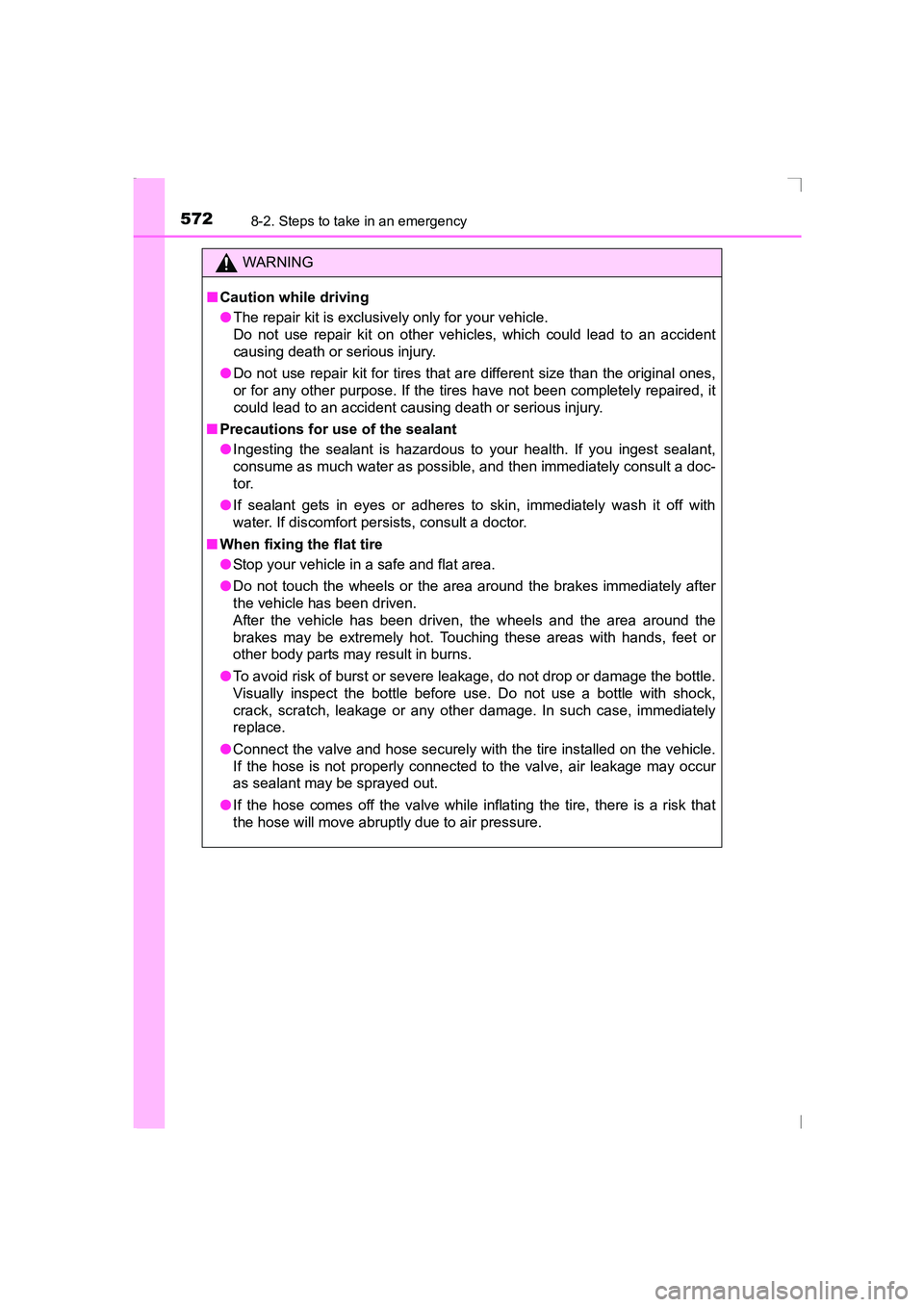
5728-2. Steps to take in an emergency
AVENSIS_OM_OM20C20E_(EE)
WARNING
■ Caution while driving
●The repair kit is exclusively only for your vehicle.
Do not use repair kit on other vehicles, which could lead to an accident
causing death or serious injury.
● Do not use repair kit for tires that are different size than the original ones,
or for any other purpose. If the tires have not been completely repaired, it
could lead to an accident causing death or serious injury.
■ Precautions for use of the sealant
●Ingesting the sealant is hazardous to your health. If you ingest sealant,
consume as much water as possible, and then immediately consult a doc-
tor.
● If sealant gets in eyes or adheres to skin, immediately wash it off with
water. If discomfort persists, consult a doctor.
■ When fixing the flat tire
●Stop your vehicle in a safe and flat area.
● Do not touch the wheels or the area around the brakes immediately after
the vehicle has been driven.
After the vehicle has been driven, the wheels and the area around the
brakes may be extremely hot. Touching these areas with hands, feet or
other body parts may result in burns.
● To avoid risk of burst or severe leakage, do not drop or damage the bottle.
Visually inspect the bottle before use. Do not use a bottle with shock,
crack, scratch, leakage or any other damage. In such case, immediately
replace.
● Connect the valve and hose securely with the tire installed on the vehicle.
If the hose is not properly connected to the valve, air leakage may occur
as sealant may be sprayed out.
● If the hose comes off the valve while inflating the tire, there is a risk that
the hose will move abruptly due to air pressure.
AVENSIS_OM_OM20C20E_(EE).book Page 572 Thursday, January 29, 2015 1:47 PM
Page 573 of 648
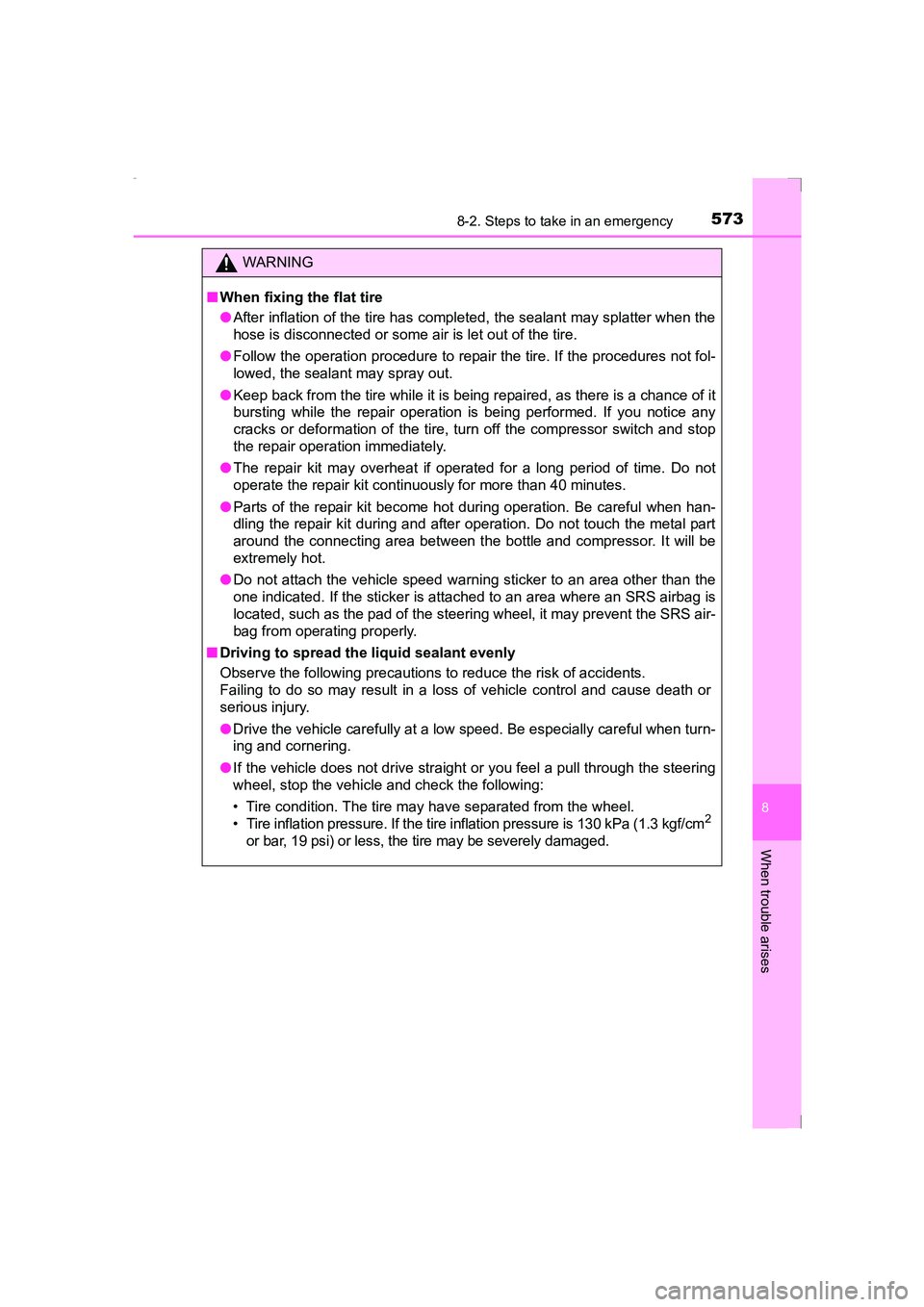
5738-2. Steps to take in an emergency
AVENSIS_OM_OM20C20E_(EE)
8
When trouble arises
WARNING
■ When fixing the flat tire
●After inflation of the tire has completed, the sealant may splatter when the
hose is disconnected or some air is let out of the tire.
● Follow the operation procedure to repair the tire. If the procedures not fol-
lowed, the sealant may spray out.
● Keep back from the tire while it is being repaired, as there is a chance of it
bursting while the repair operation is being performed. If you notice any
cracks or deformation of the tire, turn off the compressor switch and stop
the repair operation immediately.
● The repair kit may overheat if operated for a long period of time. Do not
operate the repair kit continuously for more than 40 minutes.
● Parts of the repair kit become hot during operation. Be careful when han-
dling the repair kit during and after operation. Do not touch the metal part
around the connecting area between the bottle and compressor. It will be
extremely hot.
● Do not attach the vehicle speed warning sticker to an area other than the
one indicated. If the sticker is attached to an area where an SRS airbag is
located, such as the pad of the steering wheel, it may prevent the SRS air-
bag from operating properly.
■ Driving to spread the liquid sealant evenly
Observe the following precautions to reduce the risk of accidents.
Failing to do so may result in a loss of vehicle control and cause death or
serious injury.
●Drive the vehicle carefully at a low speed. Be especially careful when turn-
ing and cornering.
● If the vehicle does not drive straight or you feel a pull through the steering
wheel, stop the vehicle and check the following:
• Tire condition. The tire may have separated from the wheel.
• Tire inflation pressure. If the tire inflation pressure is 130 kPa (1.3 kgf/cm
2
or bar, 19 psi) or less, the tire may be severely damaged.
AVENSIS_OM_OM20C20E_(EE).book Page 573 Thursday, January 29, 2015 1:47 PM
Page 574 of 648
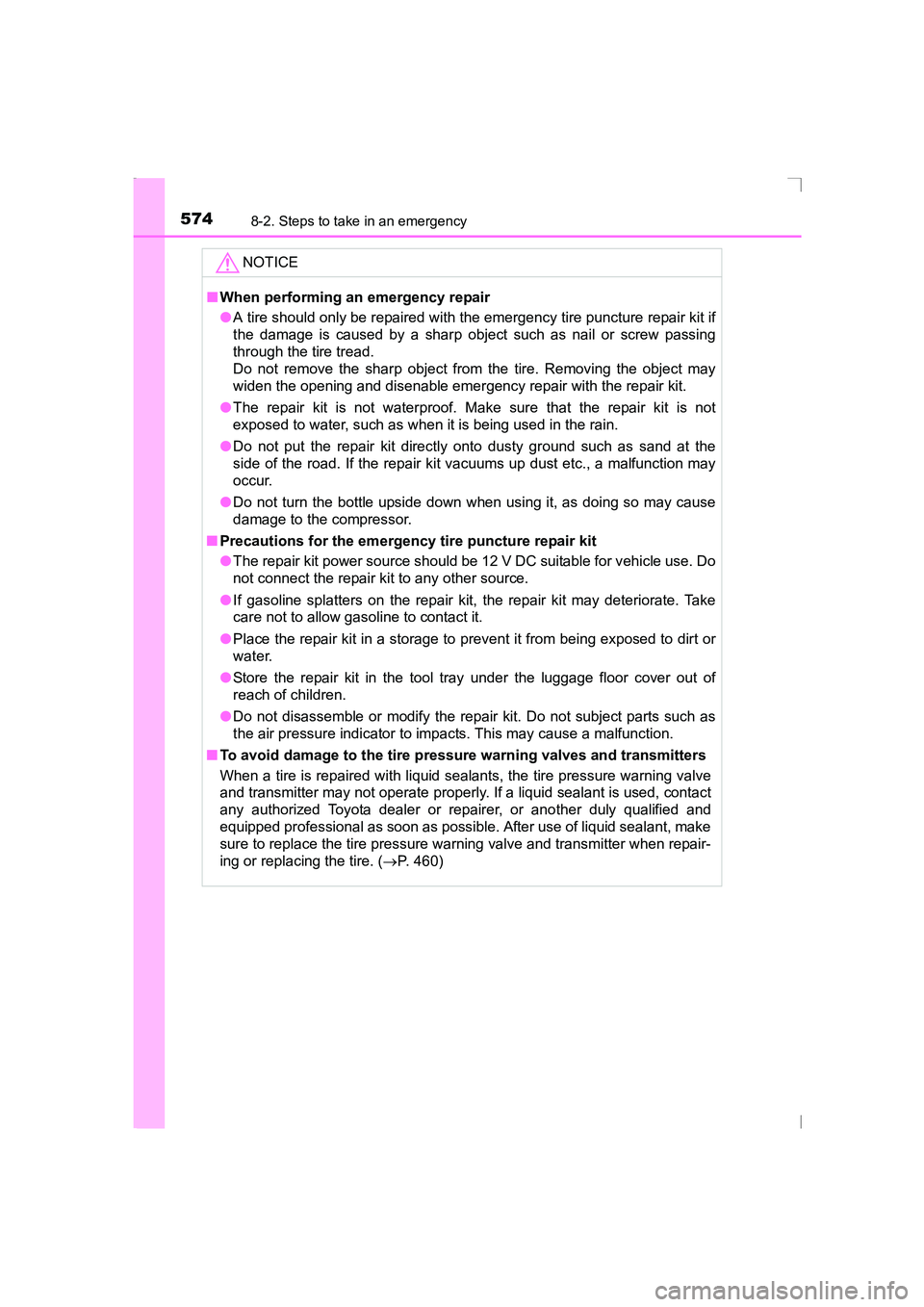
5748-2. Steps to take in an emergency
AVENSIS_OM_OM20C20E_(EE)NOTICE
■
When performing an emergency repair
●A tire should only be repaired with the emergency tire puncture repair kit if
the damage is caused by a sharp object such as nail or screw passing
through the tire tread.
Do not remove the sharp object from the tire. Removing the object may
widen the opening and disenable emergency repair with the repair kit.
● The repair kit is not waterproof. Make sure that the repair kit is not
exposed to water, such as when it is being used in the rain.
● Do not put the repair kit directly onto dusty ground such as sand at the
side of the road. If the repair kit vacuums up dust etc., a malfunction may
occur.
● Do not turn the bottle upside down when using it, as doing so may cause
damage to the compressor.
■ Precautions for the emergency tire puncture repair kit
●The repair kit power source should be 12 V DC suitable for vehicle use. Do
not connect the repair kit to any other source.
● If gasoline splatters on the repair kit, the repair kit may deteriorate. Take
care not to allow gasoline to contact it.
● Place the repair kit in a storage to prevent it from being exposed to dirt or
water.
● Store the repair kit in the tool tray under the luggage floor cover out of
reach of children.
● Do not disassemble or modify the repair kit. Do not subject parts such as
the air pressure indicator to impacts. This may cause a malfunction.
■ To avoid damage to the tire pressure warning valves and transmitters
When a tire is repaired with liquid sealants, the tire pressure warning valve
and transmitter may not operate properly. If a liquid sealant is used, contact
any authorized Toyota dealer or repairer, or another duly qualified and
equipped professional as soon as possible. After use of liquid sealant, make
sure to replace the tire pressure warning valve and transmitter when repair-
ing or replacing the tire. ( →P. 460)
AVENSIS_OM_OM20C20E_(EE).book Page 574 Thursday, January 29, 2015 1:47 PM
Page 575 of 648
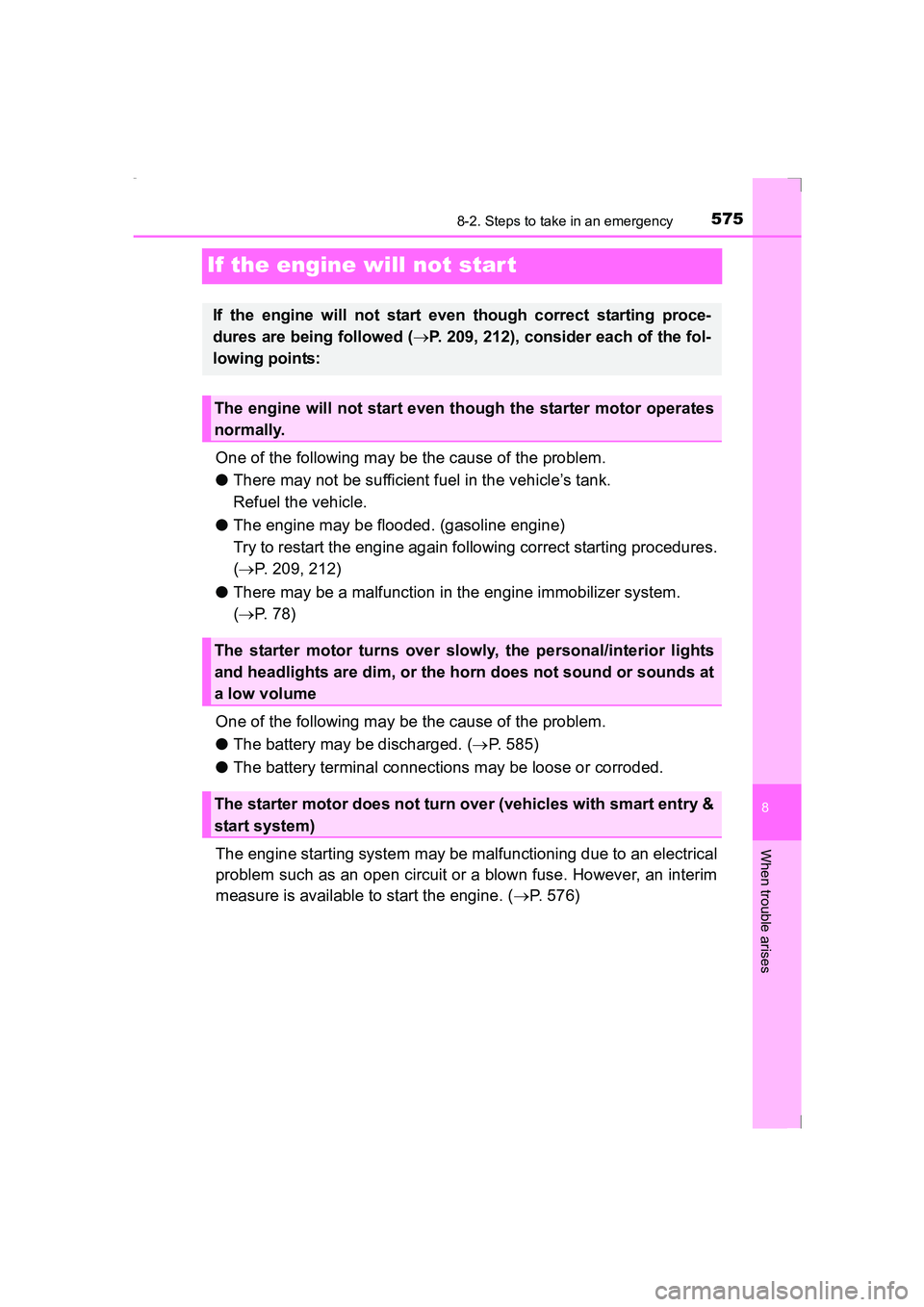
5758-2. Steps to take in an emergency
AVENSIS_OM_OM20C20E_(EE)
8
When trouble arises
If the engine will not star t
One of the following may be the cause of the problem.
●There may not be sufficient fuel in the vehicle’s tank.
Refuel the vehicle.
● The engine may be flooded. (gasoline engine)
Try to restart the engine again following correct starting procedures.
(→ P. 209, 212)
● There may be a malfunction in the engine immobilizer system.
(→ P. 7 8 )
One of the following may be the cause of the problem.
● The battery may be discharged. ( →P. 585)
● The battery terminal connections may be loose or corroded.
The engine starting system may be malfunctioning due to an electrical
problem such as an open circuit or a blown fuse. However, an interim
measure is available to start the engine. ( →P. 576)
If the engine will not start even though correct starting proce-
dures are being followed ( →P. 209, 212), consider each of the fol-
lowing points:
The engine will not start even though the starter motor operates
normally.
The starter motor turns over slowly, the personal/interior lights
and headlights are dim, or the horn does not sound or sounds at
a low volume
The starter motor does not turn over (vehicles with smart entry &
start system)
AVENSIS_OM_OM20C20E_(EE).book Page 575 Thursday, January 29, 2015 1:47 PM
Page 576 of 648
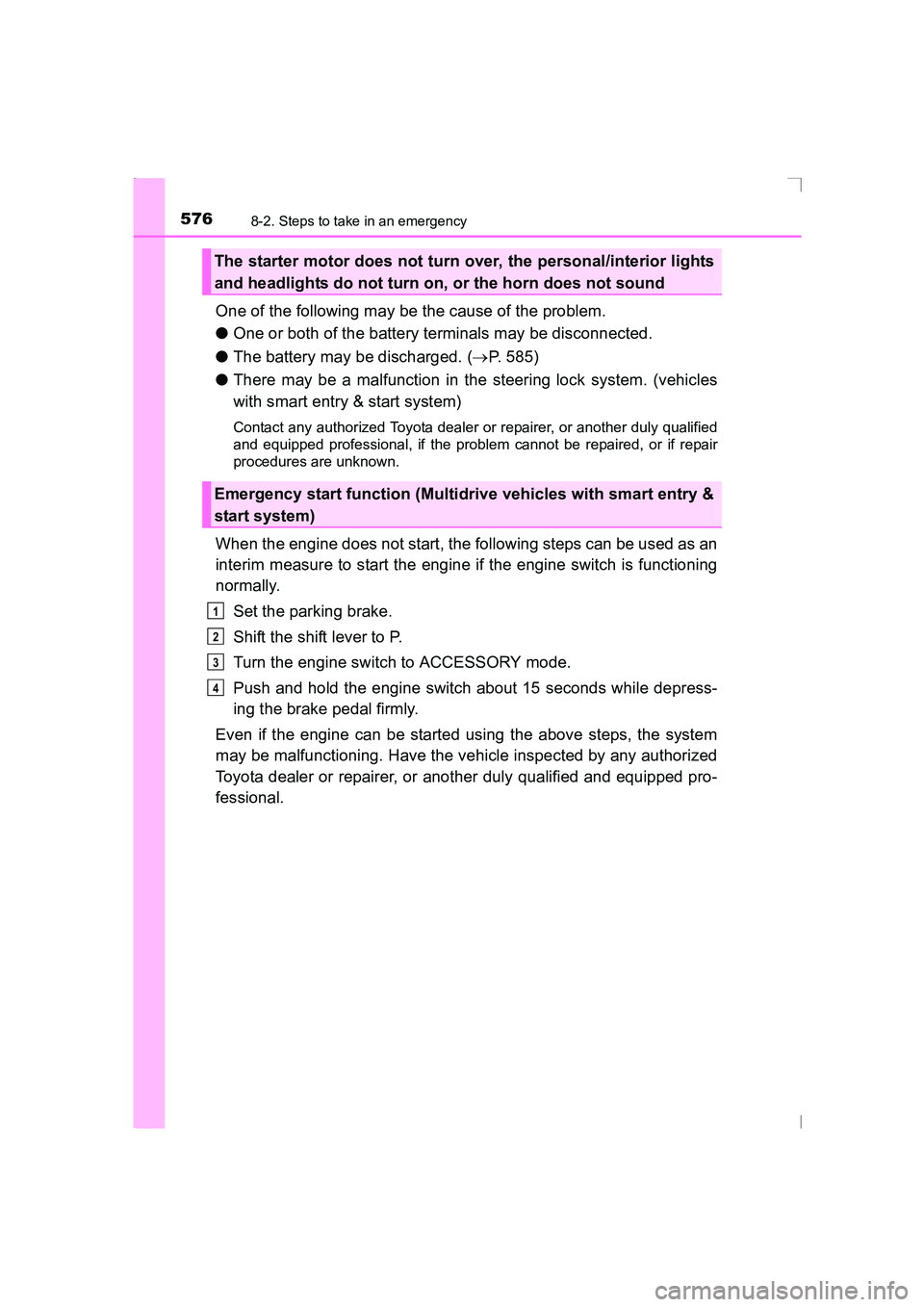
5768-2. Steps to take in an emergency
AVENSIS_OM_OM20C20E_(EE)
One of the following may be the cause of the problem.
●One or both of the battery terminals may be disconnected.
● The battery may be discharged. ( →P. 585)
● There may be a malfunction in the steering lock system. (vehicles
with smart entry & start system)
Contact any authorized Toyota dealer or repairer, or another duly qualified
and equipped professional, if the problem cannot be repaired, or if repair
procedures are unknown.
When the engine does not start, the following steps can be used as an
interim measure to start the engine if the engine switch is functioning
normally.
Set the parking brake.
Shift the shift lever to P.
Turn the engine switch to ACCESSORY mode.
Push and hold the engine switch about 15 seconds while depress-
ing the brake pedal firmly.
Even if the engine can be started using the above steps, the system
may be malfunctioning. Have the vehicle inspected by any authorized
Toyota dealer or repairer, or another duly qualified and equipped pro-
fessional.
The starter motor does not turn over, the personal/interior lights
and headlights do not turn on, or the horn does not sound
Emergency start function (Multidrive vehicles with smart entry &
start system)
1
2
3
4
AVENSIS_OM_OM20C20E_(EE).book Page 576 Thursday, January 29, 2015 1:47 PM
Page 577 of 648
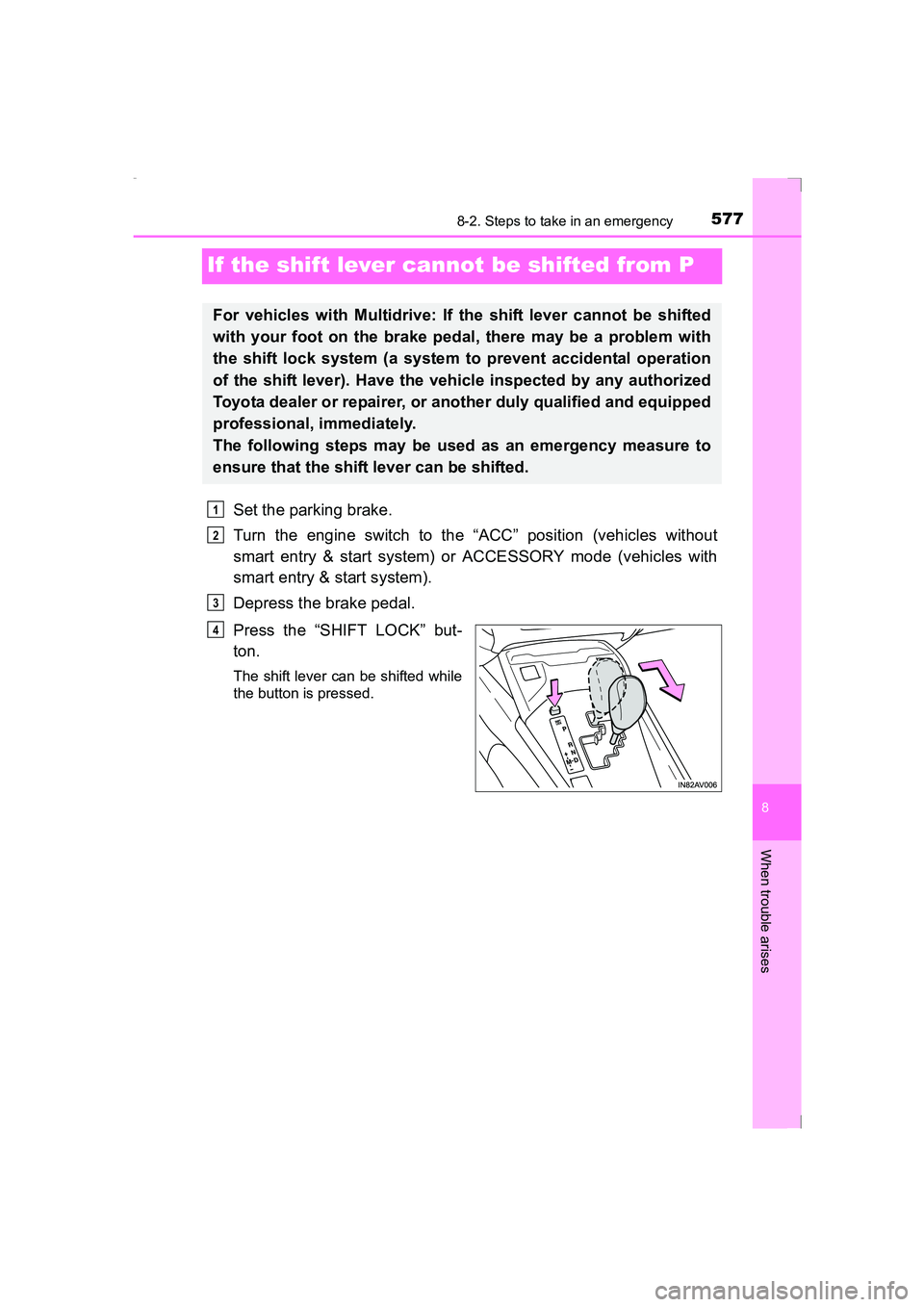
5778-2. Steps to take in an emergency
AVENSIS_OM_OM20C20E_(EE)
8
When trouble arises
If the shift lever cannot be shifted from P
Set the parking brake.
Turn the engine switch to the “ACC” position (vehicles without
smart entry & start system) or ACCESSORY mode (vehicles with
smart entry & start system).
Depress the brake pedal.
Press the “SHIFT LOCK” but-
ton.
The shift lever can be shifted while
the button is pressed.
For vehicles with Multidrive: If the shift lever cannot be shifted
with your foot on the brake pedal, there may be a problem with
the shift lock system (a system to prevent accidental operation
of the shift lever). Have the vehicle inspected by any authorized
Toyota dealer or repairer, or another duly qualified and equipped
professional, immediately.
The following steps may be used as an emergency measure to
ensure that the shift lever can be shifted.
1
2
3
4
AVENSIS_OM_OM20C20E_(EE).book Page 577 Thursday, January 29, 2015 1:47 PM
Page 578 of 648
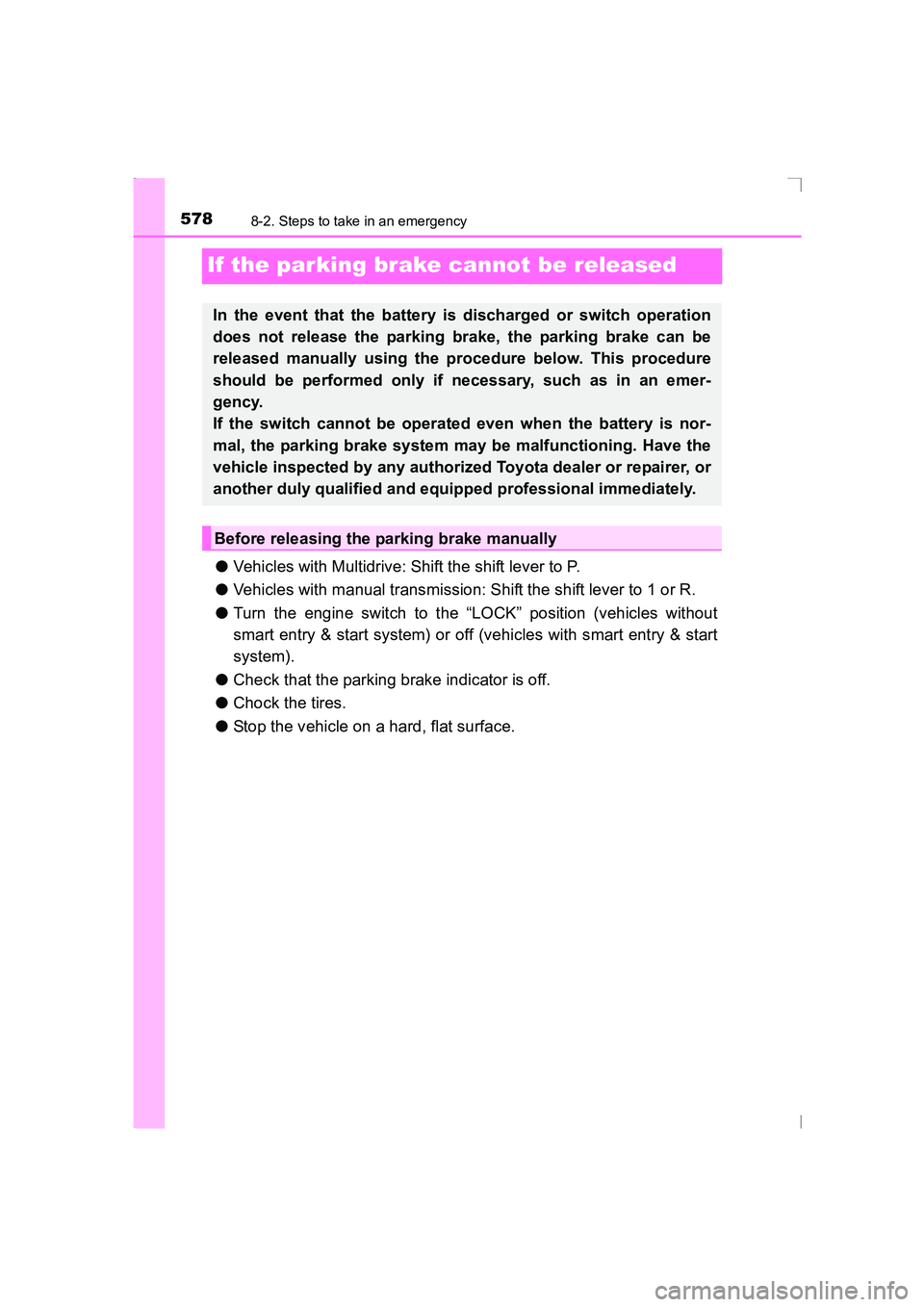
5788-2. Steps to take in an emergency
AVENSIS_OM_OM20C20E_(EE)
If the parking brake cannot be released
●Vehicles with Multidrive: Shift the shift lever to P.
● Vehicles with manual transmission: Shift the shift lever to 1 or R.
● Turn the engine switch to the “LOCK” position (vehicles without
smart entry & start system) or off (vehicles with smart entry & start
system).
● Check that the parking brake indicator is off.
● Chock the tires.
● Stop the vehicle on a hard, flat surface.
In the event that the battery is discharged or switch operation
does not release the parking brake, the parking brake can be
released manually using the procedure below. This procedure
should be performed only if necessary, such as in an emer-
gency.
If the switch cannot be operated even when the battery is nor-
mal, the parking brake system may be malfunctioning. Have the
vehicle inspected by any authorized Toyota dealer or repairer, or
another duly qualified and equipped professional immediately.
Before releasing the parking brake manually
AVENSIS_OM_OM20C20E_(EE).book Page 578 Thursday, January 29, 2015 1:47 PM
Page 579 of 648
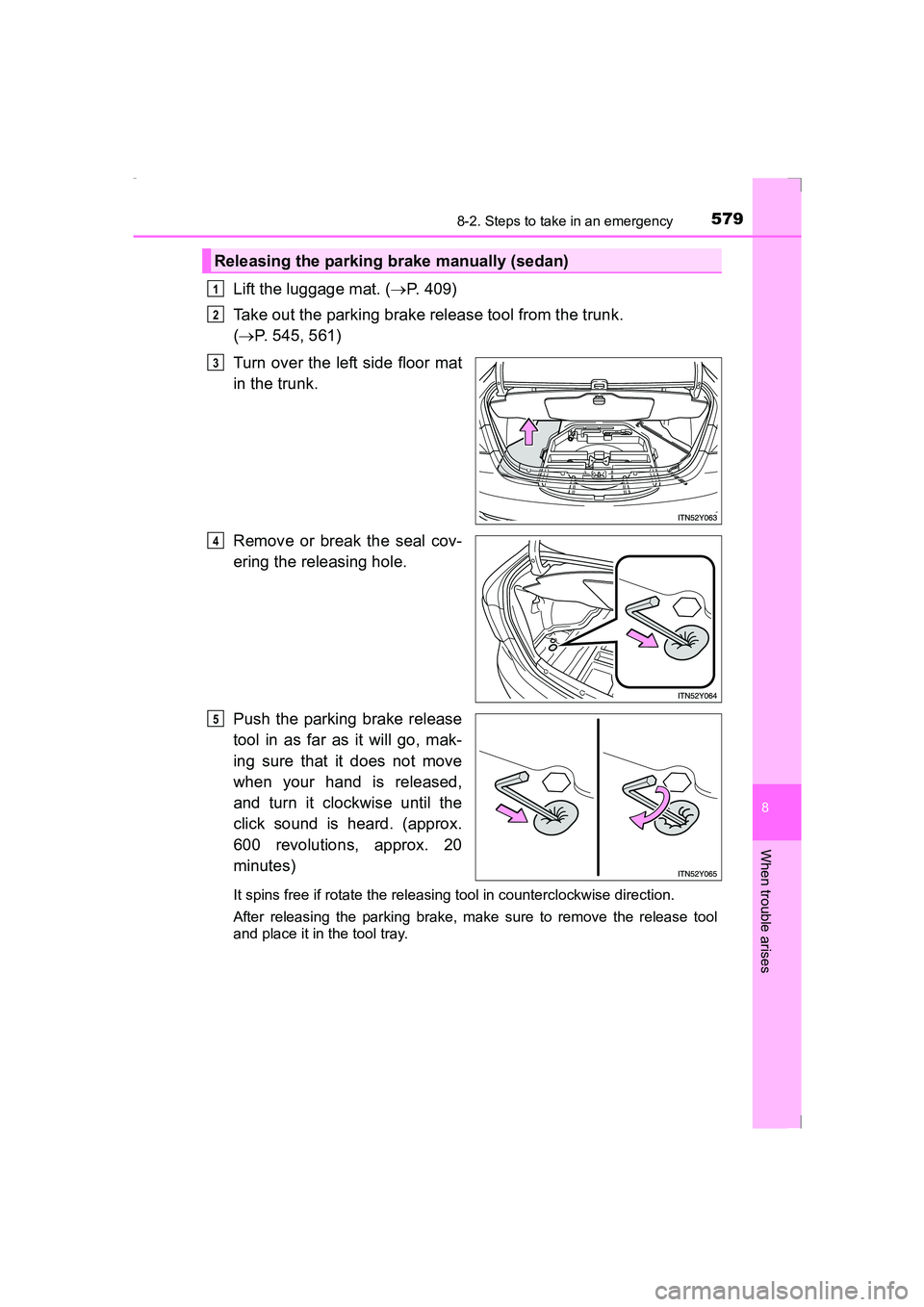
5798-2. Steps to take in an emergency
AVENSIS_OM_OM20C20E_(EE)
8
When trouble arises
Lift the luggage mat. (→P. 409)
Take out the parking brake release tool from the trunk.
( → P. 545, 561)
Turn over the left side floor mat
in the trunk.
Remove or break the seal cov-
ering the releasing hole.
Push the parking brake release
tool in as far as it will go, mak-
ing sure that it does not move
when your hand is released,
and turn it clockwise until the
click sound is heard. (approx.
600 revolutions, approx. 20
minutes)
It spins free if rotate the releasing tool in counterclockwise direction.
After releasing the parking brake, make sure to remove the release tool
and place it in the tool tray.
Releasing the parking brake manually (sedan)
1
2
3
4
5
AVENSIS_OM_OM20C20E_(EE).book Page 579 Thursday, January 29, 2015 1:47 PM
Page 580 of 648
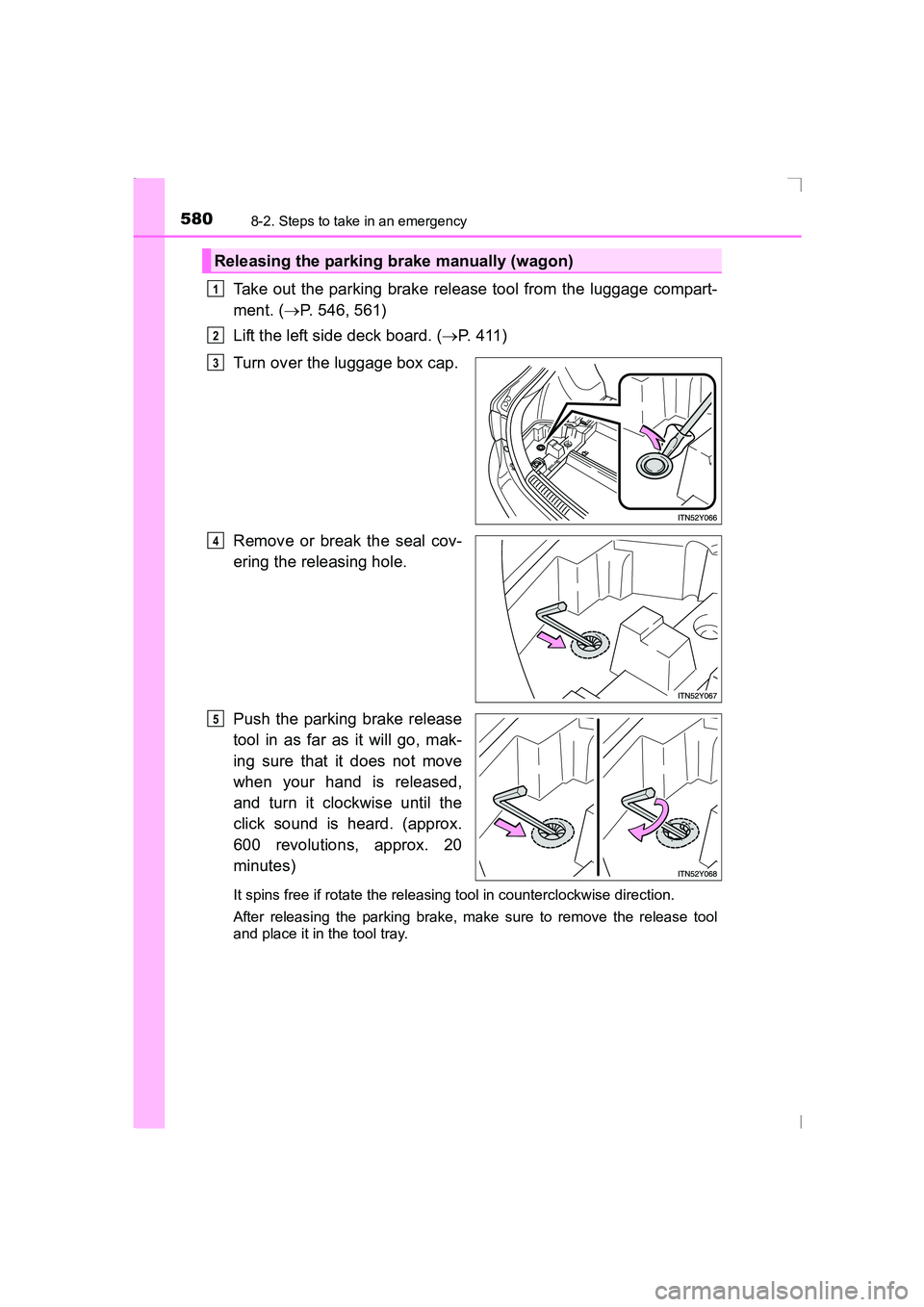
5808-2. Steps to take in an emergency
AVENSIS_OM_OM20C20E_(EE)
Take out the parking brake release tool from the luggage compart-
ment. (→P. 546, 561)
Lift the left side deck board. ( →P. 411)
Turn over the luggage box cap.
Remove or break the seal cov-
ering the releasing hole.
Push the parking brake release
tool in as far as it will go, mak-
ing sure that it does not move
when your hand is released,
and turn it clockwise until the
click sound is heard. (approx.
600 revolutions, approx. 20
minutes)
It spins free if rotate the releasing tool in counterclockwise direction.
After releasing the parking brake, make sure to remove the release tool
and place it in the tool tray.
Releasing the parking brake manually (wagon)
1
2
3
4
5
AVENSIS_OM_OM20C20E_(EE).book Page 580 Thursday, January 29, 2015 1:47 PM